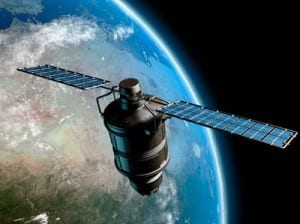Photons, spacecraft, atomic clocks and Einstein
By Clare S Ryan, on 31 October 2011
According to Professor Marek Ziebart, who gave last Thursday’s Lunch Hour Lecture, ‘Photons, spacecraft, atomic clocks and Einstein – fundamental physics in the space environment’, if it wasn’t for Einstein’s theory of relativity GPS systems would have about an 11km margin of error per day. That’s the difference between central London and Croydon – which wouldn’t be much good for locating the nearest coffee shop.
Professor Ziebart’s lecture was about how satellites – which allow technology such as mobile phones – GPS and earth surface modelling hinge upon theories that Einstein formulated more than 100 years ago.
 Diving straight in, he started by explaining that in order for satellites to work we need to know how far they are away from Earth. This is calculated using two atomic clocks, one on a tracking station on the ground and the other on a satellite, which split time into segments of up to a thousand million millionths of a second (take that Rolex).
Diving straight in, he started by explaining that in order for satellites to work we need to know how far they are away from Earth. This is calculated using two atomic clocks, one on a tracking station on the ground and the other on a satellite, which split time into segments of up to a thousand million millionths of a second (take that Rolex).
The satellite sends a signal at a very specific frequency down to the tracking station telling it the time. The tracking station’s atomic clock records the time the signal arrives, allowing it to work out how long the signal took to travel from space to Earth. With this information, you can calculate the distance to the satellite using some fairly standard GCSE physics.
So far, so good? Unfortunately not. Using some very fetching inflatable models of the Earth and a satellite, Professor Ziebart explained that Einstein’s special theory of relativity means that the clock in space runs slower than the clock on Earth. To confuse things further, the theory of general relativity dictates that things further away from a large object (such as the Earth) experience time faster than things close to a large object.
The net effect means that without accounting for Einstein’s laws, the clocks would be out by about 38 microseconds a day. This translates to 11.5km on your GPS, and a disastrous search for a coffee shop in Croydon.
So, if you’ve accounted for relativity, is there anything else which affects the position where satellites are in space? Well, yes, lots of things. Professor Ziebart’s work is on something called ‘photon pressure’. Photons are tiny particles that transmit light, and are so small that they don’t have a mass. However, they do have momentum, which means that they can exert a ‘push’ according to Einstein’s equation e=mc2 (I have to admit that the ideas lost me a bit here…)
Billions and billions of photons are being emitted from the Sun, and when they hit the satellite in space their energy is absorbed by the satellite, making it shift very slightly. Professor Zeibart models this effect, and being able to account for all these tiny pushes by photons means that the most sophisticated GPS systems can now map the Earth down to the last millimetre.
Professor Ziebart was an infectiously enthusiastic speaker, and peppered his explanations with anecdotes ranging from the ‘Einstein switch’ that the US Air Force wanted on their first GPS satellite (just in case Einstein was wrong) to references to the famous photon torpedoes in Star Trek.
What really came through, though, was his faith in science to improve our lives. Before this lecture, I knew GPS had something to do with satellites and physics, but to be honest, how it worked was not much clearer to me than the secrets of a magic trick. Knowing even the basics of Einstein’s ideas and their practical application in space technology is, if anything, an even more astounding feat than wizardry.
Watch the lecture online here:
 Close
Close

